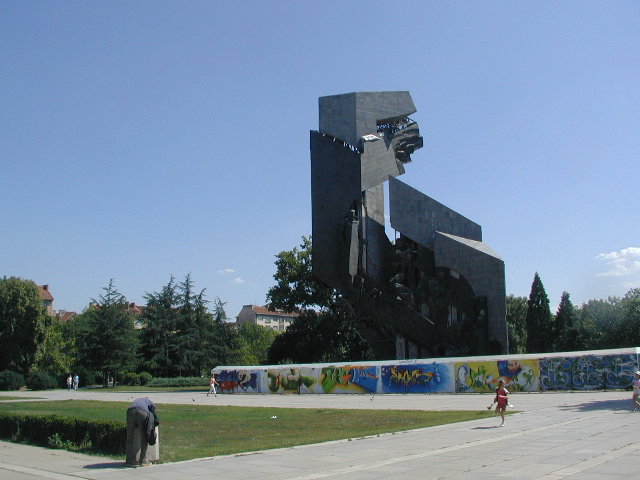
Even though I had my train ticket, I was still curious about whether there had been any way to get to Bulgaria by day. When I noticed a bus station at the side of the Thessaloniki Railroad Station, I stopped in and managed to obtain a schedule. It turns out that there are several buses a day, run by at least two companies, serving both Sofia and Plovdiv. While the Bulgarians (and Greeks) may try to keep these schedules as a state secret, there's no reason I can't transcribe the gist of them.
In short, the trans-Balkan express train is the only rail service from Thessaloniki to Sofia and leaves daily at 11:42 p.m.. (There is also an overnight train that goes to Plovdiv, via a different route.) Buses leave from Thessaloniki to Sofia at 7:30 a.m., 2 p.m., 4 p.m., 10 p.m. and midnight or 12:15 a.m.. There are some variations in this, with one bus missing each weekday. That is, there's no 2 p.m. bus on Mondays, no 7:30 a.m. bus on Tuesdays, and so on. The schedule for Plovdiv suggests that the Sofia buses just continue on, except the 2 p.m. bus. Of course, all of this will have changed by the time anybody reading it will try to use it, but it gives you an idea of the possibilities. I'd suggest the 7:30 a.m. service as the only practical alternative to the train, as the safety of bus service at night is always a bit questionable.
As for the train service, that I can speak to first hand. The Bulgarian railroad sleeper cars are all second class, with top, middle and lower berths. Two of these three-berth compartments are separated by a door that, in the case of the one I was in, didn't quite close properly. There is minimal luggage storage space - a single rack that can just barely hold a backpack. If the train is fairly empty (as mine was), this is not much of a problem. The train matron sorted out moving people around, so I ended up alone, versus having a large Bulgarian woman and her two humongous suitcases with me. The toilet door tends to stick and, while there is hot water, there's no food for sale. All in all, the best thing I can say about the Bulgarian railroad is that it's slightly better than the Mongolian railroad. The neighboring compartment (remember the door that didn't quite work?) had a loud American man and a Bulgarian woman, who quickly found the two other loudest people on the train (a British man and a Spanish woman a couple of compartments away) and got even louder. I attempted to sleep, but it was impossible, so I did the only logical thing and joined the party. As is typical of this sort of thing, much of the conversation focused on who had been where. There was a little discussion of Bulgaria though, with general interest in the fact that the country's prime minister is also their hereditary king, Tsar Simeon II.
Anyway, it took about two hours to the border. At the Greek side, they collected the non-EU passports, while just glancing at the EU ones. There was a minor complication when one guy discovered he had left his passport at home - in Belgium - and we had a delay while they put him off the train. Eventually, we got our passports back, with faint Greek exit stamps in them, and continued on to the Bulgarian side. This time all of the passports were collected and taken off to a little shack. We waited nearly two hours before the border officials returned with them. Once we got our passports back, everybody headed off to try to get a few hours of sleep before Sofia.
The train matron woke everybody up a half hour before arrival. One could theoretically buy tea or coffee from her, but the few who did said it was pretty vile, so I didn't bother. The scenery of that last half hour was a pretty poor introduction to the country, consisting of a nuclear reactor and a shanty town. The station featured the typical quota of annoying touts, who I shook off, before changing my remaining euros for Bulgarian leva (about BGN 2 = EUR 1). I had correctly figured that I was going to want some luxury after the overnight train, so had booked a room at the Hilton. Taking a taxi there, I tried to insist on the meter being used. That ended up in a negotiated fare of BGN 5. Of course, when we actually got there, the driver insisted on more, and I ended up paying BGN 7 rather than fight.
After settling in and restoring myself with a nice long shower, I set out to sightsee. The Hilton is a bit south of the center of town and getting anywhere from there requires walking past the Palace of Culture (locally known as NDK, which stands for Natsionalen Dvorets na Kulturata according to the Rough Guide) and on through Yuzhen Park. The park is quite pleasant, with lots of people out and about pretty much all day. The north end has the grotesquely modern 1300 Years Monument. I was entirely unable to find out what the reference is to and, in lieu of assuming something practical like celebrating independence from the Ottomans (who actually ruled Bulgaria only for about 500 years), I decided it must refer to 1300 years of bad taste in sculpture. (Actually, it's 1300 years of the Bulgarian republic, counting from some obscure date declaring the first republic to the erection of the statue in 1983. That doesn't make it an attractive sculpture, however.)

Fortunately, the city center is considerably nicer, with large public squares, lots of sidewalk cafes, and attractive architecture. For example, there's Sofia's oldest church, the 4th century Rotonda of Sveti George. The interior of the church is completely covered with elaborate frescoes, but it wasn't clear to me whether photography would be allowed inside, so I refrained.
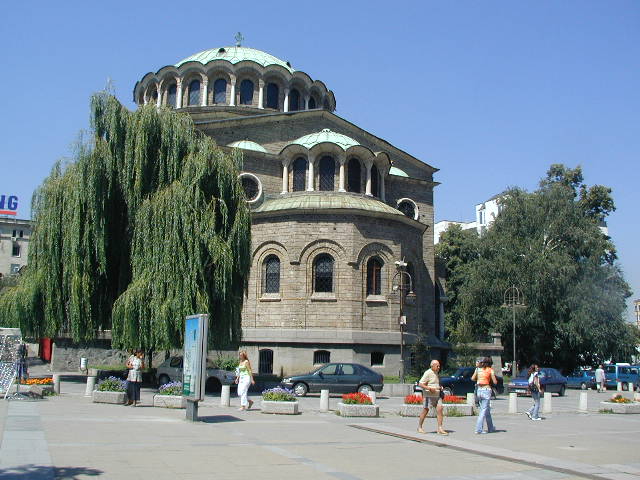
I walked over to the Presidency, where I watched the changing of the guard. This involves the same sort of goose-stepping and moderately silly uniform that is used in Greece. Then, I decided I needed lunch, so I stopped in the Art Club Museum Cafe. I had a very tasty fish dish, which involved a coating of nuts and raisins. And the atmosphere was lively and pleasant. My final sightseeing venture of the day was the Archaeological Museum, which includes a number of treasures from throughout Bulgaria, including Macedonia and Thrace. Some of the more interesting items included casket locks and keys, an engraved metal military diploma, and a carved stone piece showing the preparation for a gladiatorial fight. That's along with the usual statues of Greek gods and sarcophagi and so on. The upper floor has a lot of medieval frescoes, with a particularly interesting set from a church in Nessebar depicting the tortures of St. George. There were also two special exhibits - one from a private collection of copper age and bronze age artifacts and one of medieval jewelry. By the way, everything was labeled in English, as well as Bulgarian.
Meandering back to the Hilton, I stopped for some ice cream and discovered that the Bulgarians have mastered the art of gelato. Given that the ice cream I'd tried in Greece had been rather disappointing, this was a pleasant surprise, particularly as I didn't succeed in finding any truly memorable meals. There are adequate salads (something called shopska salad, which is basically tomatoes, cucumbers, and peppers, with grated white cheese on top) and acceptable pizza, but nothing worth going out of the way for. The cafes are more for beverages than for actual meals. The nice thing is that there's a good mix of public and commercial space, so that the parks have cafes, but also have people sitting on benches chatting and street musicians, and so on. For example, in Yuzhen Park in the evening, I saw a guy doing an escape artist routine, freeing himself from locks and chains. There was also a man playing the flute and another playing bagpipes.
The next day, I treated myself to the lavish buffet breakfast at the Hilton, which featured luxuries like smoked whitefish. I had more sightseeing to do and started out walking towards Sofia University and the National Library. Continuing on, I reached a park which had a large statue of a saint I was unable to identify. I did, however, overhear somebody telling two people that the upstretched arms were reminiscent of students bemoaning their fate after examinations.
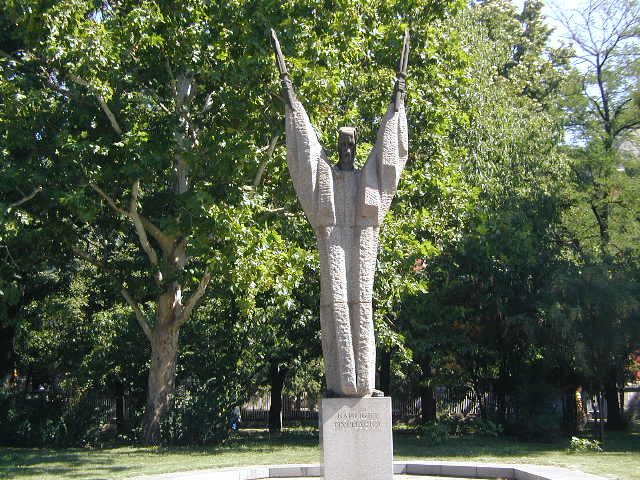
I should add a caution that I had to fend off fairly obvious attempts by would-be pickpockets. So it's worth being wary, particularly of gypsy mothers with young children. While I may recognize that the problem of petty crimes by gypsies arises largely out of the desperate poverty resulting from discrimination against them, that doesn't mean I want to remedy it out of my pockets. (If you want the political screed, the short version is this. If you refuse to give people education on the grounds that they're habitual criminals, they aren't going to have a lot of career opportunities other than crime. It's a self-perpetuating problem.)
Anyway, the obvious tourist priority is the late 19th century Alexander Nevsky Cathedral. This is, indeed, a startlingly beautiful building, with glittering gold domes.
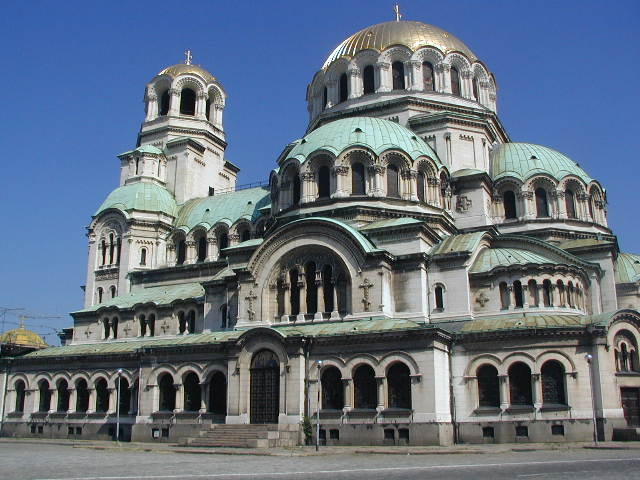
One can't take photographs inside, but you can get an idea of the quality of the frescoes from this view of one of the lunettes decorating the outside.
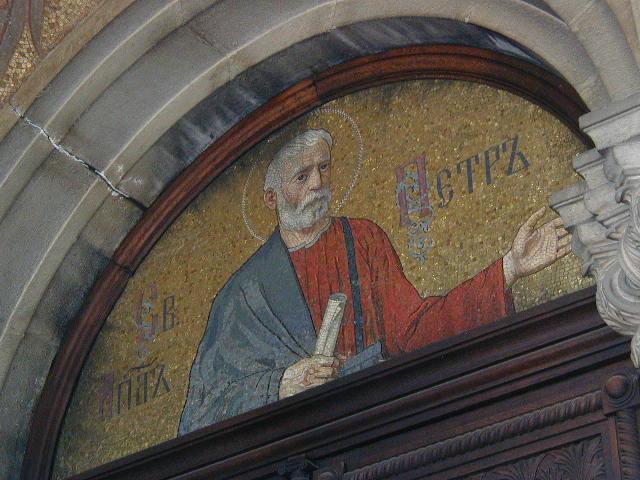
The interior is brightly colored, with lots of gilt. There's definitely a lot of Russian influence in the style. I was dismayed, however, that there were only a handful of other tourists - not more than a dozen or so.
I left and continued on through the flea market and art market that lines the park to the west. That offers a view of the front of the cathedral, but that's actually less impressive than the side view is.
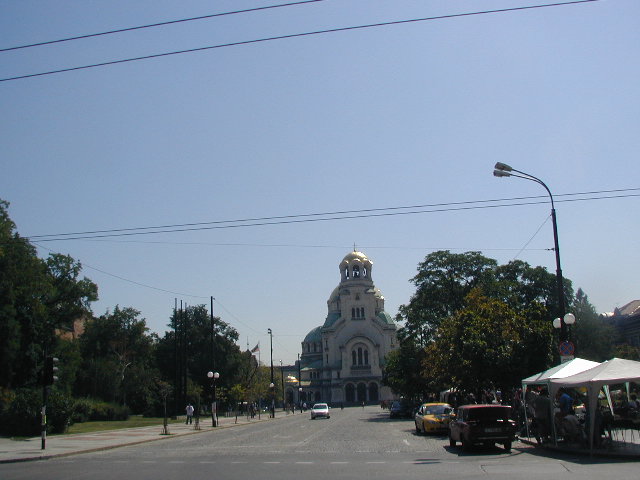
I continued to meander and found myself by the National Theatre, which is another spectacularly beautiful structure. I took advantage of a nearby cafe to rest and have a cold drink, while enjoying the splendor of the view.
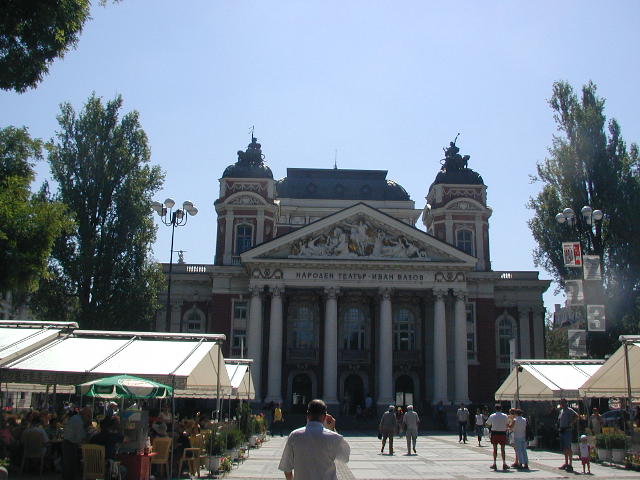
My next stop was the Ethnographic Museum, housed in part of the former royal palace. (The other half of the building houses the National Art Gallery, which I didn't visit.) Most of the exhibits are of folk costumes from various regions, including places that are currently part of Macedonia and Albania, rather than Bulgaria. The embroidery, mostly done in cross-stitch, is extremely detailed and fine. There are explanations in both English and Bulgarian, many of which are translations of descriptions by 19th century travelers. There are also photos of wooden houses and display cases of household implements, but those were of less interest to me. You exit through a well-stocked gift shop, which is as good a place as any to buy souvenirs.
Then I walked over to TZUM, which was once the state department store. Nowadays, it's a modern and upscale shopping mall, useful largely for its spotlessly clean public toilets. I continued up Maria Luiza Boulevard, past the mosque.
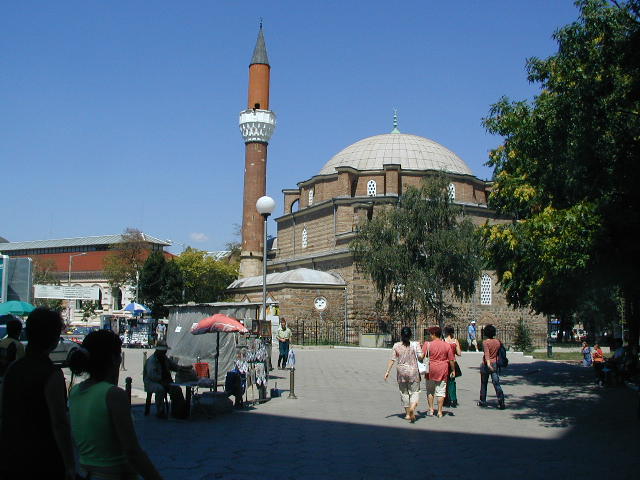
More or less across the street, there's the synagogue, which is massive and very Eastern in appearance. Bulgaria has historically had good relationships with the Jewish community, who suffered less than most in Eastern Europe during the Holocaust. Most of the Jews in Bulgaria proper (versus Macedonia and Thrace) were interned internally and survived.
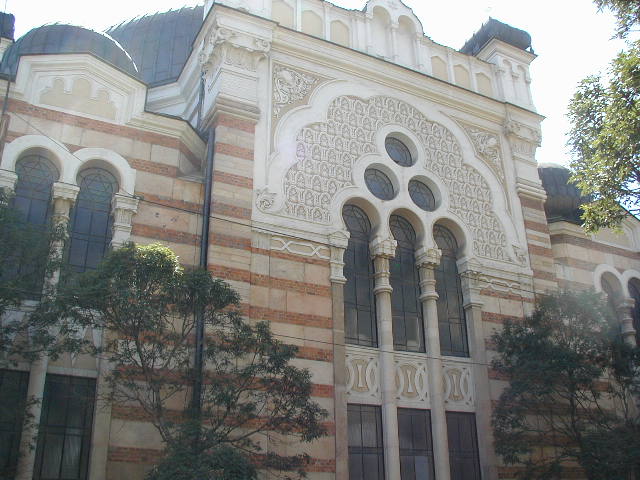
Incidentally, I should note an oddity. The churches displayed posters of people who had died recently, with a photograph and dates. I noticed the same sort of posters on a bulletin board at the synagogue entrance.
I continued walking west and soon arrived at the Zhenski Pazar or Women's Market. This is a large and interesting market, with produce (especially tomatoes and peppers) on one side and clothing on the other. Then I walked back to the center and through the Halite, an early 20th century market hall which houses some upscale food shops and a sort of food court. I happened to pass a needlework store and decided to see if they had any canvases of Bulgarian scenery. Unfortunately, my linguistic skills made this difficult. The shopkeeper spoke some Russian, but my Russian vocabulary runs to peculiar phrases like "it's a bird, it's a plane, it's Superman" and "talking cockroaches live in Asia." Eventually, another person in the store was able to tell me (in German) that all the canvases they had were the ones on display.
All in all, I really liked Sofia. It's very walkable and very clean, with spectacular architecture and well-frequented parks. However, I expect that it would be quite a difficult place to visit if one couldn't read the Cyrillic alphabet, as few street signs are in Latin characters. I also expect that will change when Bulgaria joins the European Union in 2007. Mostly, I wished I had enough time to visit other places in Bulgaria. Plovdiv is supposed to be an architectural gem and the Thracian tombs in the east would also be interesting. But I had settled for what flights I could get and that meant just a couple of days. So, in the morning, I was off to the airport.
The airport in Sofia is a bit chaotic as they allow those seeing people off to go pretty much all the way up to the security screening point. That means that you more or less have to fight your way through crowds of tearful relatives. Once through, however, it's much calmer. I had business class tickets all the way home so used the lounge, but it didn't look excessively crowded at the gate. Vienna was a different story. The business class lounge was a true retreat there, as there is entirely inadequate seating and general chaos in the terminal. Austrian Air's service was fine and the seating was particularly good, perhaps because it's really a combined business and first class, which they refer to as "grand class." We arrived at Dulles on time, or perhaps even a few minutes early, and there were no hassles there. I should probably mention that somebody got admonished for taking a photo in the immigration area, though. (Obviously somebody very naive - it's pretty much a general rule that one can't take photos at borders. And they just got yelled at, instead of having the camera confiscated, which is what would happen in most of the world.)
So what's my overall assessment of the trip? Here are a few final odds and ends:
Back to Greece | Back to Index
Xenophilia Home
last updated 12 September 2004